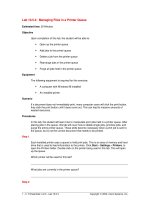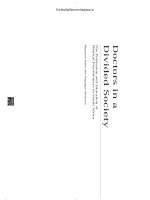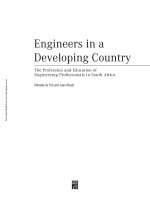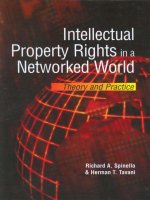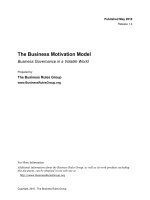GLOBAL ECONOMIC PROSPECTS: Managing growth in a volatile world doc
Bạn đang xem bản rút gọn của tài liệu. Xem và tải ngay bản đầy đủ của tài liệu tại đây (10.11 MB, 162 trang )
Global
Global
Global
Economic
Economic
Economic
Prospects
Prospects
Prospects
Volume 5
Volume 5
Volume 5
| June 2012
| June 2012
| June 2012
The World Bank
Managing growth
in a volatile
world
© 2012 The International Bank for Reconstruction and Development / The World Bank
1818 H Street NW
Washington DC 20433
Telephone: 202-473-1000
Internet: www.worldbank.org
E-mail:
All rights reserved
1 2 3 4 13 12 11 10
This volume is a product of the staff of the International Bank for Reconstruction and Development /
The World Bank. The findings, interpretations, and conclusions expressed in this volume do not neces-
sarily reflect the views of the Executive Directors of The World Bank or the governments they represent.
The World Bank does not guarantee the accuracy of the data included in this work. The boundaries, col-
ors, denominations, and other information shown on any map in this work do not imply any judgment on
the part of The World Bank concerning the legal status of any territory or the endorsement or acceptance
of such boundaries.
Rights and Permissions
The material in this publication is copyrighted. Copying and/or transmitting portions or all of this work
without permission may be a violation of applicable law. The International Bank for Reconstruction and
Development / The World Bank encourages dissemination of its work and will normally grant permis-
sion to reproduce portions of the work promptly.
For permission to photocopy or reprint any part of this work, please send a request with complete infor-
mation to the Copyright Clearance Center Inc., 222 Rosewood Drive, Danvers, MA 01923, USA; tele-
phone: 978-750-8400; fax: 978-750-4470; Internet: www.copyright.com.
All other queries on rights and licenses, including subsidiary rights, should be addressed to the Office of
the Publisher, The World Bank, 1818 H Street NW, Washington, DC 20433, USA. fax: 202-522-2422;
e-mail:
3
Global Economic Prospects
Managing growth in a volatile world
June 2012
4
Acknowledgments
This report is a product of the Prospects Group in the Development Economics Vice Presidency of the World Bank.
Its principal authors were Andrew Burns and Theo Janse van Rensburg.
The project was managed by Andrew Burns, under the direction of Hans Timmer and the guidance of Justin Yifu
Lin. Several people contributed substantively to the report. The modeling and data team was led by Theo Janse van
Rensburg assisted by Irina Magyer, Sabah Zeehan Mirza and Muhammad Adil Islam. The projections, regional
write-ups and subject annexes were produced by Dilek Aykut (Finance, Europe & Central Asia), John Baffes &
Shane Streifel (Commodities) Sanket Mohapatra (South Asia and Exchange Rates), Allen Dennis (Sub-Saharan
Africa and International Trade), Eung Ju Kim (Finance), Theo Janse van Rensburg (High-Income Countries), Elliot
(Mick) Riordan (East Asia & the Pacific, Middle-East & North Africa, and Inflation), Cristina Savescu (Latin
America & Caribbean, Industrial Production). Regional projections and annexes were produced in coordination with
country teams, country directors, and the offices of the regional Chief Economists and PREM directors. The short-
term commodity price forecasts were produced by John Baffes, Betty Dow, and Shane Streifel. The
remittances forecasts were produced by Dilip K. Ratha and Ani Silwal. Simulations were performed by Theo van
Rensburg, Irina Magyer and Sanket Mohapatra.
The accompanying online publication, Prospects for the Global Economy, was produced by a team comprised of
Sarah Crow, Sanket Mohapatra, Sabah Mirza, Muhammad Adil Islam, Betty Dow, Vamsee Krishna Kanchi, and
Katherine Rollins with technical support from David Horowitz, Ugendran Machakkalai, and Malarvishi Veerappan.
Roula I. Yazigi and Sabah Zeehan Mirza were responsible for the cover artwork.
Indira Chand, Cynthia Case-McMahon and Merrell Tuck-Primdahl managed media relations and the dissemination.
Hazel Macadangdang managed the publication process.
Several reviewers offered extensive advice and comments. These included Inger Andersen, Ulrich Bartsch, Maria
Teresa Benito-Spinetto, Fabio Bittar, Zeljko Bogetic, Otaviano Canuto, Shubham Chaudhuri, Jeff Chelsky, Punam
Chuhan-Pole, Tito Cordella, Jorg Decressin, Augusto de la Torre, Shantayanan Devarajan, Tatiana Didier, Pablo
Fajnzylber, Manuela V. Ferro, Caroline Freund, Bernard G. Funck, David Michael Gould, Marcelo Giugale, Bert
Hofman, Zahid Hussain, Elena Ianchovichina, Kalpana Kochhar, Auguste Tano Kouame, Roumeen Islam, Jeffrey
D. Lewis, Philippe H. Le Houerou, Jose R. Lopez Calix, Ernesto May, Alexey Morozov, Antonio M. Ollero, Sam-
uel Pienknagura, Bryce Quillin, Christine M. Richaud, Sudhir Shetty, Vijay Srinivas Tata, Phil Suttle, Anthony G.
Toft, Yvonne M. Tsikata, Willem van Eeghen, Jan Walliser.
5
Table of Contents
Main Text ………………………………………………………………………… … 1
Topical Annexes
Industrial production ………………………………………………………………… 31
Inflation. ……………………………………………………………………………… 37
Recent developments in financial markets …………………………………………… 43
Trade …………………………………………………………………………….…… 53
Exchange rates …………………………………………………………………… ….…59
Prospects for commodity markets ……………………………………………….….… 67
Regional Annexes
East Asia & the Pacific ……………………………………………… … … …….…79
Europe & Central Asia ………………………………………………… ……… … …89
Latin America & the Caribbean …………………………………… …………… ….101
Middle East & North Africa ……………………………………………………… … 115
South Asia ………………………………………………………….……………… 127
Sub-Saharan Africa ……………………………………………….………………… 143
The cut off date for information included in this edition of the Global Economic Prospects
reflects data as of June 8, 2012.
Economic developments of the past year have
been volatile, punctuated by natural disasters,
large swings in investor sentiment, and periods
of relative calm and improving prospects. Output
in the second half of 2011, was particularly
weak, buffeted by flooding in Thailand, the
delayed impact of earlier policy tightening and a
resurgence of financial market and investor
jitters.
In contrast, economic news during the first four
months of 2012 was generally positive.
Significant structural, fiscal and monetary policy
steps in high-income Europe during the fourth
quarter of 2011 and the first quarter of 2012
contributed to a significant improvement in
market sentiment, and less constraining financial
conditions. This combined with monetary policy
easing in developing countries was reflected in a
strengthening of real-side economic activity in
both developing and high-income countries.
Annualized growth rates for industrial
production, import demand and capital goods
sales returned to positive territory with
developing countries leading the rebound.
Increased Euro Area jitters have reversed
earlier improvements in market sentiment
Most recently, market tensions have jumped up
again, sparked by fiscal slippage, banking
downgrades, and political uncertainty in the
Euro Area. The renewed market nervousness has
caused the price of risk to spike upwards
globally. In the Euro Area, measures of financial
market tension, such as Credit Default Swap
(CDS) rates, have risen to levels close to their
peaks in the fall of 2011. In other high-income
countries, CDS rates have risen somewhat less
sharply. Among most developing countries, CDS
rates are currently about 65 to 73 percent of
peak levels, and between 77 and 90 percent for
countries in the Europe & Central Asia region.
Other financial market indicators have also
deteriorated, with developing– and high-income
country stock markets losing about 10 percent
(at their recent trough) since May 1st, giving up
almost all of the gains generated over the
preceding 4 months. They have since recovered
about half that value. Yields on high-spread
economies were also driven upwards, while
those of safe-have assets declined. Virtually all
developing economy currencies have depreciated
against the US dollar, while industrial
commodity prices such as oil and copper have
also fallen sharply (19 and 14 percent
respectively).
Renewed tensions will add to pre-existing
headwinds to keep GDP gains modest
Assuming that conditions in high-income Europe
do not deteriorate significantly, the increase in
tensions so far can be expected to subtract about
0.2 percentage points from Euro Area growth in
2012. The direct effect on developing country
growth will be smaller (in part because there has
been less contagion), but increased market
jitters, reduced capital inflows, high-income
fiscal and banking-sector consolidation are all
expected to keep growth weak in 2012. These
drags on growth are expected to ease somewhat,
and global growth strengthen during 2013 and
2014, although both developing-country and
high-income country GDP will grow less quickly
than during the pre-crisis years of this century.
Taking these factors into account, global GDP is
projected to increase 2.5 percent in 2012, with
growth accelerating to 3.0 and 3.3 percent in
2013 and 2014 (table 1). Output in the Euro Area
is projected to contract by 0.3 percent in 2012,
reflecting both weak carry over and increased
precautionary saving by firms and households in
response to renewed uncertainty. Overall, high-
income GDP is expected to expand only 1.4
percent this year weighed down by banking-
sector deleveraging and ongoing fiscal
Global Economic Prospects June 2012:
Managing growth in a volatile world
Overview & main messages
2
Table 1 The Global Outlook in summary
(percent change from previous year, except interest rates and oil price)
2010 2011 2012e 2013f 2014f
Global Conditions
World Trade Volume (GNFS) 13.0 6.1 5.3 7.0 7.7
Consumer Prices
G-7 Countries
1,2
1.2 2.4 1.9 1.8 2.0
United States 1.6 3.1 2.6 2.4 2.5
Commodity Prices (USD terms)
Non-oil commodities 22.5 20.7 -8.5 -2.2 -3.1
Oil Price (US$ per barrel)
3
79.0 104.0 106.6 103.0 102.4
Oil price (percent change) 28.0 31.6 2.5 -3.4 -0.6
Manufactures unit export value
4
3.3 8.9 0.9 1.2 1.5
Interest Rates
$, 6-month (percent) 0.5 0.5 0.7 0.8 1.1
€, 6-month (percent)
1.0 1.6 1.0 1.1 1.4
International capital flows to developing countries (% of GDP)
Developing countries
Net private and official inflows 5.8 4.6 3.3 3.6 3.8
Net private inflows (equity + debt) 5.4 4.4 3.1 3.4 3.7
East Asia and Pacific 5.9 4.9 3.3 3.4 3.5
Europe and Central Asia 4.9 4.4 2.6 3.7 3.9
Latin America and Caribbean 6.1 4.8 3.9 3.9 4.0
Middle East and N. Africa 2.3 0.0 1.0 1.7 2.2
South Asia 5.2 3.7 2.8 3.0 3.5
Sub-Saharan Africa 3.6 3.4 2.6 3.3 4.3
Real GDP growth
5
World 4.1 2.7 2.5 3.0 3.3
Memo item: World (PPP weights)
6
5.1 3.7 3.3 3.9 4.2
High income 3.0 1.6 1.4 1.9 2.3
OECD Countries 2.9 1.4 1.3 1.8 2.2
Euro Area 1.8 1.6 -0.3 0.7 1.4
Japan 4.5 -0.7 2.4 1.5 1.5
United States 3.0 1.7 2.1 2.4 2.8
Non-OECD countries 7.4 4.8 3.6 4.3 4.1
Developing countries 7.4 6.1 5.3 5.9 6.0
East Asia and Pacific 9.7 8.3 7.6 8.1 7.9
China 10.4 9.2 8.2 8.6 8.4
Indonesia 6.2 6.5 6.0 6.5 6.3
Thailand 7.8 0.1 4.3 5.2 5.6
Europe and Central Asia 5.4 5.6 3.3 4.1 4.4
Russia 4.3 4.3 3.8 4.2 4.0
Turkey 9.2 8.5 2.9 4.0 5.0
Romania -1.6 2.5 1.2 2.8 3.4
Latin America and Caribbean 6.1 4.3 3.5 4.1 4.0
Brazil 7.5 2.7 2.9 4.2 3.9
Mexico 5.5 3.9 3.5 4.0 3.9
Argentina 9.2 8.9 2.2 3.7 4.1
Middle East and N. Africa 3.8 1.0 0.6 2.2 3.4
Egypt
7
5.0 1.8 2.1 3.1 4.2
Iran 2.9 2.0 -1.0 -0.7 1.5
Algeria 3.3 2.5 2.6 3.2 3.6
South Asia 8.6 7.1 6.4 6.5 6.7
India
7, 8
9.6 6.9 6.6 6.9 7.1
Pakistan
7
4.1 2.4 3.6 3.8 4.1
Bangladesh
7
6.1 6.7 6.3 6.4 6.5
Sub-Saharan Africa 5.0 4.7 5.0 5.3 5.2
South Africa 2.9 3.1 2.7 3.4 3.5
Nigeria 7.9 7.4 7.0 7.2 6.6
Angola 3.4 3.4 8.1 7.4 6.8
Memorandum items
Developing countries
excluding transition countries 7.8 6.4 5.5 6.1 6.2
excluding China and India 5.6 4.4 3.6 4.3 4.5
7
8
Source: World Bank.
Notes: PPP = purchasing power parity; e = estimate; f = forecast.
1. Canada, France, Germany, Italy, Japan, the UK, and the United States.
2. In local currency, aggregated using 2005 GDP Weights.
3. Simple average of Dubai, Brent and West Texas Intermediate.
4. Unit value index of manufactured exports from major economies, expressed in USD.
5. Aggregate growth rates calculated using constant 2005 dollars GDP weights.
6. Calculated using 2005 PPP weights.
In keeping with national practice, data for Egypt, India, Pakistan and Bangladesh are reported on a fiscal year basis in Table 1.1.
Aggregates that depend on these countries, however, are calculated using data compiled on a calendar year basis.
Real GDP at market prices. GDP growth rates calculated using real GDP at factor cost, which are customarily reported in India, can
vary significantly from these growth rates and have historically tended to be higher than market price GDP growth rates. Growth rates
stated on this basis, starting with FY2010-11 are 8.4, 6.5, 6.9, 7.2, and 7.4 percent – see Table SAR.2 in the regional annex.
3
consolidation. As these pressures ease in 2013
and 2014, rich-country GDP growth is projected
to firm to what will still be a modest 1.9 and 2.3
percent pace in each of 2013 and 2014.
GDP in developing countries is projected to
expand 5.3 percent in 2012. Still weak, but
strengthening high-income demand, weak capital
flows, rising capital costs and capacity
constraints in several large middle-income
countries will conspire to keep growth from
exceeding 6 percent in each of 2013 and 2014.
The projected recovery in the Middle-East &
North Africa is uncertain and is contingent on
assumptions of a gradual easing of social unrest
during 2012 and a return to more normal
conditions during 2013 and 2014.
In the baseline, the slower growth in developing
countries mainly reflects a developing world that
has already recovered from the financial crisis.
Several countries are rubbing against capacity
constraints that preclude a significant
acceleration in growth, and may even require a
slowing in activity in order to prevent
overheating over the medium run.
Should global conditions deteriorate, all
developing countries would be hit — making the
replenishment of depleted macroeconomic
cushions a priority
The resurgence of tensions in the high-income
world is a reminder that the after effects of the
2008/09 crisis have not yet played themselves
out fully. Although the resolution of tensions
implicit in the baseline is still the most likely
outcome, a sharp deterioration of conditions
cannot be ruled out. While the precise nature of
such a scenario is unknowable in advance,
developing countries could be expected to take a
large hit. Simulations suggest that their GDP
could decline relative to baseline by more than
four percent in some regions, with commodity
prices, remittances, tourism, trade, finance and
international business confidence all
mechanisms by which the tribulations of the
high-income world would be transmitted to
developing countries. Countries in Europe and
Central Asia would be among the most
vulnerable to an acute crisis in high-income
Europe, with likely acceleration in deleveraging
by Greek banks affecting Bulgaria, Macedonia
and Serbia the most.
A return to more neutral macroeconomic policies
would help developing countries reduce their
vulnerabilities to external shocks, by rebuilding
fiscal space, reducing short-term debt exposures
and recreating the kinds of buffers that allowed
them to react so resiliently to the 2008/09 crisis.
Currently, developing country fiscal deficits are
on average 2.5 percent of GDP higher than in
2007, and current account deficits 2.8 percent of
GDP higher. And short-term debt exceeds 50
percent of currency reserves in 11 developing
countries.
A more neutral and less reactive policy stance
will help even if a crisis is averted
Even in the absence of a full-blown crisis,
elevated fiscal deficits and debts in high-income
countries (including the United States and
Japan), and the very loose monetary policies
being pursued in the high-income world,
suggests that for the next several years the
external environment for developing economies
is likely to remain characterized by volatile
capital flows and volatile business sentiment.
As a result, sharp swings in investor sentiment
and financial conditions will continue to
complicate the conduct of macro policy in
developing countries. In these conditions, policy
in developing countries needs to be less re-active
to short-term changes in external conditions, and
more responsive to medium-term domestic
considerations. A reactive macroeconomic
policy runs the risk of being pro-cyclical, with
the impact of a loosening (tightening) in
response to a temporary worsening
(improvement) of external conditions stimulating
(restraining) domestic demand at the same time
as external conditions recover (weaken).
For the many developing economies that have,
or are close to having fully recovered from the
crisis, policy needs to turn away from crisis-
fighting and re-prioritize the kinds of
productivity-enhancing reforms (like investment
in human capital and regulatory reform) that will
support a durable pickup in growth rates over the
longer term.
Global Economic Prospects June 2012 Main Text

